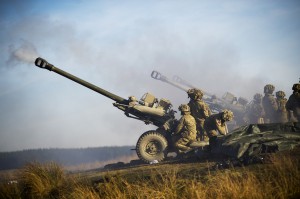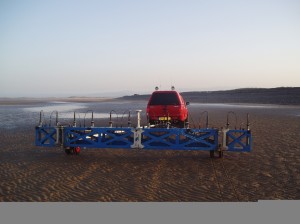I’m Paul Burden and I lead DIO’s Explosive Ordnance Clearance (EOC) team.
DIO runs the military training estate, which includes firing ranges used by all three Services. This can be artillery, as well as missiles fired from ships and aircraft. Explosive ordnance clearance is the systematic identification and retrieval of historic ordnance, which is another word for bombs.

In simple terms, we look for ordnance on both the Ministry of Defence (MOD) estate and on land which has been sold off or returned to the landowner after formal MOD use.
Getting geophysical
We work with Military Explosive Ordnance Disposal (EOD) teams from all three Services - namely the Army’s 33 Engr Regt EOC Group, 5131 (BD) SQN RAF and the Royal Navy Southern Diving Unit (SDU). My team use geophysical surveys to locate the potential ordnance for the military teams who then excavate, identify and dispose of the items.
My staff have specialist knowledge and experience. Some are former military personnel with ordnance clearance and disposal experience from the RAF and Royal Navy. Others are environmental assessment specialists. My own background lies in risk assessment and risk management. The seven-strong team is based in Corsham, but we work on sites across the UK and occasionally overseas.
Projectiles and pyrotechnics
An example of our current work is at Cowden, where a former Air Weapons Range is due to be sold. The site was in use for some 60 years as both an air and land weapons range.
Ordnance including tank projectiles, practice bombs, rockets, cannon ammunition and pyrotechnics was used on the range, located on the Yorkshire coast, where there is a high rate of coastal erosion.
Working with colleagues in DIO’s Land Management Service, we divided the site into four areas. Each area is to be treated differently in terms of the explosive risk management strategy for disposal.

The last few years have seen some changes for my team. These have generally been positive and allowed us to build our profile within the MOD.
Prior to 2011, the team was part of the Environmental Science Group at Defence Equipment and Support (DE&S), another part of the MOD. When DIO was created in April 2011 we transferred into the new organisation.
Change and restructuring
DIO’s new operating model came into force in April 2013, resulting in a name change for our team and significant organisational restructuring, with a number of people moving jobs. This opened up people's way of looking at DIO and has allowed us to promote the team to new areas of the MOD.
So why has the new operating model been important for EOC? Ordnance disposal is relatively new to many DIO staff and we are now the in-house experts for EOC.
Our work supports many areas of DIO’s mission. It allows continued use of the training estate, safe onward sale of surplus land, redevelopment work on the estate and risk management of legacy ordnance issues on alienated land.
4 comments
Comment by James Mitchelson posted on
I'm currently working as an EOC Engineer commercially (uk based) and have developed my EOD skills within the geophysical survey area. I am very interested in working within DIO in the EOC role and would be interested to know how to apply directly for this position.
Comment by DIO Communications Team posted on
Hi James, thanks for reading and for your interest in DIO.
DIO jobs are advertised on https://www.civilservicejobs.service.gov.uk/csr/index.cgi so your best bet would be to set up a job alert with relevant keywords. You'll then get an email when there's a vacancy matching those keywords and can apply directly through that website.
Good luck!
Comment by Brian Bursell posted on
Any information on Cowden the RAF range now that it has been sold I been told that there are to be some static caravan sites are being offered on the site. Many thanks Brian EX RAF
Comment by DIO Communications Team posted on
Hi Brian, the future of the site is a matter for the owners, so it's not something we can comment on.